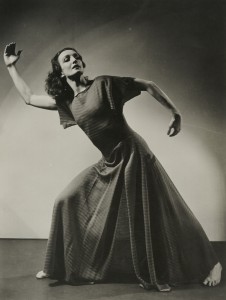Doris Humphrey (1895-1958): dancer, choreographer, and dance theorist
![]() Guide: Modern Dance in America
Guide: Modern Dance in America
- Doris Humphrey was notable for her carefully conceived and wholly original method and theory of dance, and her works were founded on both artistic philosophies and practical principles. The Art of Making Dances, a book Humphrey penned in the last years of her life, elucidates her theories of choreography.
- Humphrey was primarily interested in rigorously exploring the expressive power that movement alone is capable of, rather than utilizing dance as a theatrical medium (although she did create narrative works). She was among the first choreographers to create dances without musical accompaniment. She also created works incorporating non-musical sounds and speech.
- Her method of movement was rooted in the concept of fall and recovery: the use of gravity, and the articulation of accents and rhythms within organic movements. This was complementary to—but distinct from—Martha Graham‘s movement style based on contraction and release and the use of breath.
- Like Martha Graham and Charles Weidman, Humphrey got her start dancing with Denishawn. Due to philosophical differences with Denishawn, she left in 1926 along with Weidman and dancer/pianist/costume designer/manager Pauline Lawrence. They then formed the Humphrey-Weidman dance company in New York City.
- Humphrey stopped dancing in 1944, due to arthritis in her hip. She taught and choreographed works for the Jose Limon Dance Company for years after. Jose Limon had been a member of Humphrey’s company and he became recognized as a dancer-choreographer in his own right.
- Check out this detailed timeline from the Doris Humphrey Society.
Some characteristic works:
- Water Study (1928), a dance for a group—without a musical score—featured undulating, organic movements developed from the pulse of the dancers’ breathing. [Watch a reconstruction of this piece on YouTube]
- The Shakers (1931) is perhaps Humphrey’s most enduring work.
- New Dance trilogy (1936) completed at the Bennington Festival (three dances: Theatre Piece, With My Red Fires, and New Dance). This was of the first long Modern dances—about 3 hours in total—and considered by leading critics to be the greatest dance of its time.
- Passacaglia (1938), a “music visualization” for 25 dancers (in the tradition of Denishawn’s music visualization works) to the music of Bach.
Related Posts:
I consulted these sources in researching Humphrey’s work:
Mazo, Joseph H. Prime Movers: The Makers of Modern Dance in America. Princeton, 2000.
Reynolds, Nancy, and Malcolm McCormick. No Fixed Points: Dance in the Twentieth Century. Yale UP, 2003.
